
Safari Tours to Tarangire National Park in Tanzania
Safari Tours to Tarangire National Park in Tanzania: Customized Safaris to Fit Any Budget
Safari excursions to Tarangire National Park in Tanzania reveal a captivating landscape that is situated between the Masai Steppe meadows to the southeast and the Great Rift Valley lakes to the north and west. The park’s northern expanse is dominated by the perennial Tarangire River, which provides life to expansive swamps that convert into lush plains during the dry season in the south. The park spans 2,600 square kilometers.
Consider lodging in the southern region of Tarangire National Park, which is less frequently visited, for a more intimate and uncrowded experience. The Tarangire River, the park’s most distinctive feature, is a permanent fixture that generates expansive wetlands that are typically dry for the majority of the year. Tarangire is characterized by a vibrant vegetation, which includes extensive acacia woodlands, picturesque strands of aquatic forest, and abundant elephant grass, despite being drier than the Serengeti.
Seasonal Patterns and Wildlife Diversity
Tarangire National Park is a dynamic ecosystem, and the diversity of fauna is contingent upon the changing seasons. Many animals migrate out of the park from November to May, as they are connected to the broader ecosystem. Zebras and wildebeests disperse across the immense open expanses of the Masai Steppe as they migrate northwest toward the Rift Valley floor during this period. In contrast, the Tarangire swamps experience a resurgence of wildlife during the dry season, particularly from June to October, which is an ideal time for exceptional animal viewing.
The habitat of elephants, wildebeests, zebras, impalas, eland, buffalo, giraffes, Bohor reedbuck, Thompson’s gazelle, greater and lesser kudu, Coke’s hartebeest, and occasionally the elusive gerenuk and fringe-eared Oryx is Tarangire. In the southern open areas, leopards, lions, hyenas, and cheetahs are frequently observed; however, wild canines are more rarely observed.
Tarangire boasts an impressive avian diversity, with more than 500 species identified. Bird enthusiasts will be particularly pleased with this. Some of the most notable species are the elusive starlings and yellow-collared lovebirds.
The optimal period for safari tours to Tarangire National Park is as follows:
The optimal period for safari tours to Tarangire National Park is from late June to October, during the middle and conclusion of the dry season. Animals gather in the vicinity of the Tarangire River during this time, resulting in an unparalleled wildlife viewing experience. The weather is benevolent, with sunshine and minimal precipitation.
The high season, which spans from June to October, draws a significant number of visitors. In contrast, the wet season is at its apex in March and April, and April to May are considered the low season due to the less favorable weather conditions.
Comprehending the Geography and Climate of Tarangire
During the dry season, animals migrate into Tarangire, which encounters a classic dry reserve climate. The simplicity of wildlife observation is further enhanced by the congregation of wildlife around water points and the thinning of the vegetation. The dry season, which spans from June to October, is distinguished by a plethora of wildlife in the vicinity of water sources, reduced mosquito activity, and gorgeous, sunny weather.
The wet season, which occurs from November to May, is characterized by lush vegetation, reduced prices as a result of its low season, and ideal conditions for bird viewing. Nevertheless, the rainy season’s zenith in March to May leads to a reduction in wildlife sightings as numerous animals depart the park.
Tarangire’s weather is temperate and enjoyable, with afternoon showers. The park undergoes a year-round transition from lush vegetation to uniformly dry, green landscapes.
Road Access to Tarangire National Park: Tarangire is frequently included in the northern safari circuit, and it is frequently visited in conjunction with the Serengeti and Ngorongoro Crater. Numerous excursions to this circuit commence in Arusha.
By Air: Convenient access to Tarangire is available by flying into Kilimanjaro International Airport (KIA), which is situated 46 kilometers from Arusha, or Julius Nyerere International Airport (DAR) near Dar es Salaam, and connecting to Arusha Airport (ARK). Another alternative is to fly into Nairobi, Kenya, and then transfer to a shuttle which will take you to Arusha.
Charter Flights: A comfortable and efficient mode of transportation, charter flights from Arusha to Serengeti and then Tarangire are available.
Safari Sightseeing and Attractions
The Tarangire River, Baobab trees, and diverse biodiversity of Tarangire National Park are its most notable features. The park is a must-visit destination in northern Tanzania due to its captivating landscape and the large populations of elephants.
Safari enthusiasts may participate in walking excursions to investigate the park’s splendor. These excursions offer a distinctive opportunity to observe wildlife in their natural habitat and observe smaller animals up close without any disturbance.
Explore the African wilderness by visiting the Maasai or Barabaig villages, which are adorned with ancient murals. The Dodoma road voyage to Kolo provides a cultural perspective to your safari, providing a glimpse into the local traditions and heritage.
Conclusion: Southern regions of Tarangire National Park are characterized by an authentic appeal, despite being one of the least visited parks in northern Tanzania. The park’s seasonal patterns, migratory movements, and diverse wildlife make it a captivating destination for safari devotees, spanning 2,600 square kilometers.
Tarangire guarantees a comprehensive and immersive experience, regardless of whether you elect to visit during the dry season for the best wildlife viewing or the wet season for birdwatching. Contact us to guarantee a seamless and unforgettable voyage through this extraordinary natural wonder for a customized safari to Tarangire National Park in Tanzania.


